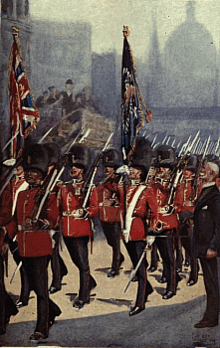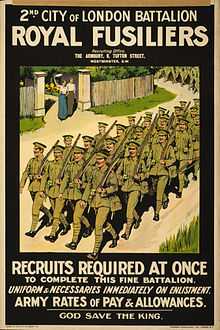Royal Fusiliers
| Royal Fusiliers (City of London Regiment) | |
|---|---|
|
Badge of the Royal Fusiliers | |
| Active | 1685–1968 |
| Country |
|
| Branch |
|
| Type | Infantry |
| Role | Line infantry |
| Size |
1–4 Regular Battalions |
| Garrison/HQ | Tower of London |
| Nickname | The Elegant Extracts |
| Motto | Honi soit qui mal y pense |
| March | The Seventh Royal Fusiliers |
The Royal Fusiliers (City of London Regiment) was an infantry regiment of the British Army until 1968 when it was amalgamated with other regiments to form the Royal Regiment of Fusiliers.
It was known as the 7th Regiment of Foot until 1881.[1] The Royal London Fusiliers Monument, a memorial dedicated to the Royal Fusiliers who died during World War I, stands on Holborn in the City of London.
History

Formation
It was formed as a fusilier regiment in 1685 by Lord Dartmouth, George Legge, from two companies of the Tower of London guard, and was originally called the Ordnance Regiment. Most regiments were equipped with matchlock muskets at the time, but the Ordnance Regiment were armed with flintlock fusils. This was because their task was to be an escort for the artillery, for which matchlocks would have carried the risk of igniting the open-topped barrels of gunpowder.
Nomenclature
The regiment became the 7th Regiment of Foot (Royal Fusiliers) in 1751, although a variety of spellings of the word "fusilier" persisted until the 1780s, when the modern spelling was formalised.[2] In 1881, under the Childers Reforms when regimental numbers were abolished the regiment became The Royal Fusiliers (City of London Regiment).[3]
American War of Independence
The Royal Fusiliers were sent to Canada in 1773. The regiment was broken up into detachments which served at Montreal, Quebec, Fort Chambly and Fort St Johns (Saint-Jean-sur-Richelieu). In the face of the American invasion of Canada in 1775/76, most of the regiment was forced to surrender. The 80 man garrison of Fort Chambly attempted to resist a 400 man Rebel force but ultimately had to surrender. This is where the regiment lost its first set of colours. Captain Owen's company of the 7th, along with a handful of recruits assisted with the defence of Quebec.
The men taken prisoner during the defence of Canada were exchanged to British held New York City in late 1776. Here the regiment was rebuilt and garrisoned New York and New Jersey. In October 1777, the 7th participated in the successful assaults on Fort Clinton and Fort Montgomery. In December 1777, the regiment reinforced the garrison of Philadelphia. During the British evacuation back to New York City, the regiment participated in the June 1778 Battle of Monmouth. The following year, the 7th participated in Tryon's raid.
Late in 1779, the Royal Fusiliers were brigaded with the 23rd Regiment of Foot for the capture of Charleston. Once Charleston fell, the regiment helped garrison the city. A detachment of 80 men was sent to Camden, South Carolina where they supervised the building of fortifications.
In January of 1781, four companies of the Royal Fusiliers were detached from General Cornwallis's army. The men were initially intended to reinforce the British fort at Ninety Six but was eventually attached to a Light Infantry force under the command of Banastre Tarleton. Tarleton was defeated at the Battle of Cowpens on 17 January. The 7th lost 171 officers and men, along with their second set of regimental colours (which were stored in the army's baggage wagons). Tarleton tried to blame his defeat partially on the 7th by claiming they were almost entirely recruits. However, the regiment's rolls show that only 38 of the men killed or captured at the Cowpens were recruits. The rest of the regiment were seasoned veterans. In fact, according to Lawrence Babits' book, A Devil of a Whipping, the greatest casualties inflicted on Daniel Morgan's army were suffered by the troops who opposed the 7th.
While the men on Tarleton's command were marching towards defeat, another 18 men of the regiment remained with Cornwallis's army. These men fought through North Carolina, participating in the Battle of Guilford Courthouse, and eventually ended up in Virginia where they joined with the Light Infantry company of the Royal Fusiliers. These men eventually were forced to surrender with the rest of the British Army at Yorktown in October of 1781.
There was another detachment which remained in the South, under the command of Lt Col. Alured Clarke. These men remained in garrison in Charleston, until they were transferred to Savannah, Georgia in December of 1781. This detachment successfully helped defend coastal Georgia from Rebel attacks until the garrison was evacuated to New York City in 1782. The shattered remains of the 7th Regiment of Foot were some of the last British soldiers to leave the New York after the Treaty of Paris ended the American Revolution in 1783.
French Revolution and Napoleonic Wars
The Royal Fusiliers formed part of the famed Fusilier Brigade in Wellington's Peninsular Army along with the 23rd Regiment of Foot (The Royal Welch Fusiliers) at the Battle of Albuhera on 16 May 1811.[4]
First World War


The Royal Fusiliers served with distinction in the First World War,[5] raising 76 battalions who wore the regimental cap badge. They served on the Western Front, in Africa, the Middle East and Macedonia. Members of the Royal Fusiliers won the first two Victoria Crosses of the war near Mons in August 1914 (Lieutenant Maurice Dease and Private Sidney Godley), and the last two in North Russia.
The Stock Exchange Battalion of the Royal Fusiliers was formed in 1914 when 1,600 members of the Exchange joined up: 400 were killed during the war. The 23rd and 24th (Service) Battalion, better known as the Sportsman's Battalions, were among the Pals battalions.[6] The 25th (Frontiersmen) Battalion, Royal Fusiliers served in East Africa. The 38th through 42nd Battalions of the regiment served as the Jewish Legion[7] in Palestine; many of its members went on to be part of the founding of the State of Israel in 1948.[8]
The Royal London Fusiliers Monument, a war memorial, stands on High Holborn, near Chancery Lane tube station, surmounted by the lifesize statue of a World War I soldier, and its regimental chapel is at St Sepulchre-without-Newgate.
Second World War
In World War II the 1st Battalion was part of the 17th Indian Infantry Brigade for the majority of the war and they were attached to the 8th Indian Infantry Division and served with them in the Italian Campaign.
The 2nd Battalion was attached to the 12th Infantry Brigade, 4th Infantry Division and was sent to France in 1939 after the outbreak of war to join the British Expeditionary Force. In May 1940 they fought in the Battle of Dunkirk and were then evacuated from France.
Post 1945
In August 1952 the regiment entered the Korean War. On 23 April 1968 the regiment was amalgamated with the Royal Northumberland Fusiliers (5th Ft), The Royal Warwickshire Fusiliers (6th Ft) and the Lancashire Fusiliers (20th Ft) to form 3rd Bn. The Royal Regiment of Fusiliers.[9]
Fusiliers Museum
The Fusilier Museum is located in the Royal Regiment of Fusiliers Headquarters at HM Tower of London. Displays include uniforms, flags, silver, insignia, medals, photographs, personal artefacts and war souvenirs. Admission is included with entry to the Tower of London.
Battle honours
- Namur 1695, Martinique 1809, Talavera, Busaco, Albuhera, Badajoz, Salamanca, Vittoria, Pyrenees, Orthes, Toulouse, Peninsula, Alma, Inkerman, Sevastopol, Kandahar 1880, Afghanistan 1879-80, Relief of Ladysmith, South Africa 1899-1902
- The Great War (47 battalions): Mons, Le Cateau, Retreat from Mons, Marne 1914, Aisne 1914, La Bassée 1914, Messines 1914 '17, Armentières 1914, Ypres 1914 '15 '17 '18, Nonne Bosschen, Gravenstafel, St. Julien, Frezenberg, Bellewaarde, Hooge 1915, Loos, Somme 1916 '18, Albert 1916 '18, Bazentin, Delville Wood, Pozières, Flers-Courcelette, Thiepval, Le Transloy, Ancre Heights, Ancre 1916 '18, Arras 1917 '18, Vimy 1917, Scarpe 1917, Arleux, Pilckem, Langemarck 1917, Menin Road, Polygon Wood, Broodseinde, Poelcappelle, Passchendaele, Cambrai 1917 '18, St. Quentin, Bapaume 1918, Rosières, Avre, Villers Bretonneux, Lys, Estaires, Hazebrouck, Béthune, Amiens, Drocourt-Quéant, Hindenburg Line, Havrincourt, Épéhy, Canal du Nord, St. Quentin Canal, Beaurevoir, Courtrai, Selle, Sambre, France and Flanders 1914-18, Italy 1917-18, Struma, Macedonia 1915-18, Helles, Landing at Helles, Krithia, Suvla, Scimitar Hill, Gallipoli 1915-16, Egypt 1916, Megiddo, Nablus, Palestine 1918, Troitsa, Archangel 1919, Kilimanjaro, Behobeho, Nyangao, East Africa 1915-17
- The Second World War: Dunkirk 1940, North-West Europe 1940, Agordat, Keren, Syria 1941, Sidi Barrani, Djebel Tebaga, Peter's Corner, North Africa 1940 '43, Sangro, Mozzagrogna, Caldari, Salerno, St. Lucia, Battipaglia, Teano, Monte Camino, Garigliano Crossing, Damiano, Anzio, Cassino II, Ripa Ridge, Gabbiano, Advance to Florence, Monte Scalari, Gothic Line, Coriano, Croce, Casa Fortis, Savio Bridgehead, Valli di Commacchio, Senio, Argenta Gap, Italy 1943-45, Athens, Greece 1944-45
- Korea 1952-53
Colonels
- 1832–1854: Sir Edward Blakeney
- 1854–1855: George Brown
- 1855–1868: Samuel Benjamin Auchmuty [10]
- 1868–1876: Sir Richard Airey [11]
- Colin Donald, succeeded by Sir Reginald Pinney
- 1924–1933: Sir Reginald Pinney
- Walter Hill (British Army officer), successor to Sir Reginald Pinney
See also
The Royal Fusiliers were mentioned in Pink Floyd's film The Wall. It was the regiment that the character Pink's father died in, as well as the writer and producer Roger Waters' father, Eric Fletcher Waters, to whom the Pink Floyd album The Final Cut was dedicated.
The Royal Fusiliers is also mentioned in Jeffrey Archer's bestseller novel, As the Crow Flies. The protagonist of the book, Charlie Trumper, is part of the regiment which fights in the First World War.
References
- ↑ Westlake, R. English and Welsh Infantry Regiments: An illustrated Record of Service (195) Stroud,GLS,UK Spellmount) ISBN 1-873376-24-3
- ↑ "Universal Register; London, Birth Day". The Times. Jun 6, 1785. p. 2.
Orders are given for a camp to be formed on Ashford-Common, near Winsor, for the 7th regiment of foot, who are to be employed in making new roads, and repairing others; the private men are to have 1s. per day extra for their labour.
- ↑ "House Of Commons, Thursday, June 23". The Times. Jun 24, 1881. p. 6.
- ↑ "Lisbon Papers; Cadiz, May 7". The Times. 29 May 1811. p. 2.
Lord Wellington has also sent two divisions of his army, the 3d and 7th, that way... Intelligence is just received that the battle is fought, and we are again victorious. The affair took place at Albuhera, on the 16th: Soult attacked, and was defeated with immense loss on both sides.
- ↑ Gray,W.E. The 2nd City of London Regiment-Royal Fusiliers-in the Great War, 1914-19 (1929, London, Seeley,Service &Co)
- ↑ Mullen, Peter, Tearing down religious standards Northern Echo 19 Mar 2002
- ↑ http://jewishmag.com/148mag/jewish_legion/jewish_legion.htm
- ↑ The Royal Fusiliers (City of London Regiment) in 1914-1918
- ↑ "New Fusilier Regiment". The Times. Apr 17, 1968. p. 12.
The Royal Regiment of Fusiliers, a new regiment, with national rather than regional loyalties, is to be formed on St. George's Day, April 23, the Ministry of Defence announced yesterday.
- ↑ The London Gazette: no. 21676. p. 1054. 13 March 1855. Retrieved 16 August 2009.
- ↑ The London Gazette: no. 23379. p. 2804. 15 May 1868. Retrieved 16 August 2009.
External links
 Media related to Royal Fusiliers (City of London Regiment) at Wikimedia Commons
Media related to Royal Fusiliers (City of London Regiment) at Wikimedia Commons- Historical records of the 7th or Royal regiment of Fusiliers 1685-1903 by Lt Col. Percy Groves.
- Fusilier Museum London
- Fusiliers Association
| ||||||||||||||||||
